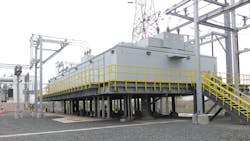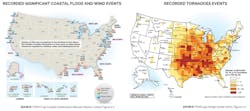Is My Substation Ready for the Next Extreme Event?
The reliability and resiliency of the electric grid is one of the primary concerns of an electric utility. While there are many challenges in maintaining a robust infrastructure, severe weather-related events and other extraordinary events pose a threat to the electrical grid that may catch utilities unprepared. Not only have these extreme events occurred with greater frequency recently, but many substation infrastructures may have not been designed to withstand these extreme events.
From 1900 to 2010, severe weather events — primarily hurricanes, typhoons, and other intense storms — have steadily grown in frequency along coastal regions of the U.S. and its territories. As the data clearly shows, these events have grown even more frequent in a relatively short period. Tornados also pose a significant threat to most regions of the midwestern United States.
Resources Are Evolving in Response
Utilities have traditionally referred to ASCE 113 for substation structural designs. This publication, titled Substation Structure Design Guide, is generally based on ASCE 7-05 with modifications to better suit substation structural designs. This guide covers extreme wind and seismic loadings but does not provide any provisions related to extraordinary events such as floods, hurricanes, tornadoes, and tsunamis.
Extraordinary Event Load Characteristics
Although each extreme event is triggered by a different source and its load characteristics are addressed in separate sections of codes and standards, there are some similarities among these events related to how the loads cause damage to structures. Hurricane and tornado events produce high winds. In addition to wind loads, hurricanes can also cause a storm surge resulting in area floods.
ASCE 7 does not contain a specific chapter addressing hurricane loads. Instead, the effects of hurricane events are addressed separately within different chapters depending on load type, either extreme wind or flood loadings. The associated chapters for both wind and flood loads – Chapter 26 and Chapter 5, respectively – must be referenced to determine hurricane design loads as these loads can occur simultaneously in coastal regions. In addition to ASCE 7, ASCE 24, Flood Resistant Design and Construction — is an excellent resource for designs and considerations for structures resisting flood loads. Flood depth and flood velocity are key design parameters used for computing wave runup and crest heights and thus are key metrics to determine criteria for flood loadings.
Due to the models utilized in the development of ASCE 7-16 Chapter 6, Tsunami loads provided are only applicable to Alaska, Washington, Oregon, California, and Hawaii. For other regions where a tsunami is determined to be a threat, ASCE 7-16 suggests that the site-specific procedure, outlined in Chapter 6, could be developed and used in conjunction with other recommendations provided. Like coastal flooding, the two key parameters used for computing loadings caused by tsunamis are inundation depth, effectively “water depth”, and flow velocity.
Case Study for Load Comparison
A case study was performed to quantify the magnitude of the various loads of extreme events in comparison to each other with the intent of providing clarity on how these loads can affect substation structural designs. The case study compared the base shear results from different extreme events acting on a substation control building. The extreme events considered in the case study include a 115 mile per hour gust wind speed (Category II hurricane), tsunami loads with and without debris impact, and a 150 mile per hour gust wind speed (Category IV hurricane) including flood loads with and without wave load.
Since there is no standard providing guidelines for designing substation infrastructures under these extreme events, the comparison from this case study could provide guidance as to how utilities choose to include or exclude each load component that best suits their acceptable risk. Also, it should be noted that results from the case study are based on certain variables and design assumptions. Different site locations and design assumptions may yield different outcomes.
Considerations for Extreme Events
Most extreme event load effects considered in ASCE standards and various FEMA guidelines are generally geared toward building designs. However, there are several load aspects described in these standards and guidelines that could still be applied to substations, e.g., a control enclosure that is similar to an enclosed building and contains many electrical components critical to substation operations. Here are a few additional suggestions and considerations:
1. Water infiltration can cause severe damage to electrical equipment, particularly in a control enclosure. It is recommended that building envelopes, such as doors, windows, and skylights, be tested in accordance to ASTM E1886 and ASTM E1996.
2. Erosion and scour during flood events are concerns addressed by ASCE 24, Section 2.5. Slab-on-grade foundations are not recommended in coastal high hazard areas due to their susceptibility to larger scour depths. Additionally, when using deep foundations, increased foundation loads must be considered due to higher foundation reveals and reduced embedment depths from the effects of erosion and scour.
3. Consider performance-based design when designing substations, as withstanding the entirety of prescribed loads may not be economical or practical. Section 1.3 of FEMA 543 describes how performance-based design could be leveraged as an alternative approach to design. This could allow utilities to establish acceptable risk and performance levels for their assets and allow tailored design requirements to better align operational goals during and after extreme events.
4. Alternatives to withstand tsunami loads are addressed in Section 6.15 of ASCE 7-16 with providing three options 1) to protect against tsunami inundation, 2) to elevate structures 1.3 times above inundation elevation, and 3) to design to withstand effects of tsunami loads.
5. Protective coatings addressed in section 3.3.1.2 of FEMA 543 suggests that greater-than-normal thickness should
be specified when a substation is within 3,000 feet of the ocean.
6. Helpful design checklists and best practices are available from a number of resources that are relevant to substation applications, including:
- FEMA P-424 for a checklist for buildings exposed to high winds.
- FEMA 543 for best practices in hurricane-prone regions and a checklist for critical facilities exposed to high winds.
Consult Appropriate Resources
There is a growing concern over the risks to power grids posed by more frequent occurrences of extreme events. Still, despite these growing risks, the effort and costs of hardening the entire network should be carefully evaluated for practicality.
Caleb Jergensen, PE, ([email protected]) is a staff structural engineer at Burns & McDonnell specializing in the structural design of electrical substations with a focus on renewable collection and interconnection in the company’s Transmission & Distribution division.
Connor Bowen PE, ([email protected]) is a senior structural engineer at Burns & McDonnell with specializing in electrical substation design and
construction in the company’s Transmission & Distribution division.
Prapon Somboonyanon, Ph.D., SE, PE, ([email protected]) is a principal engineer at AEC Lionstech, specializing in structural and seismic designs of high-voltage electrical substations throughout the U.S. and Canada.
About the Author
Caleb Jergensen
Caleb Jergensen, PE, ([email protected]) is a staff structural engineer at Burns & McDonnell specializing in the structural design of electrical substations with a focus on renewable collection and interconnection in the company’s Transmission & Distribution division.
Prapon Somboonyanon
Prapon Somboonyanon, Ph.D., SE, PE, ([email protected]) is a principal engineer at AEC Lionstech, specializing in structural and seismic designs of high-voltage electrical substations throughout the U.S. and Canada.





